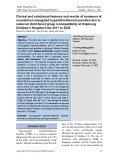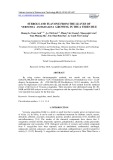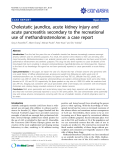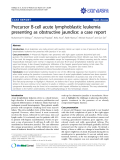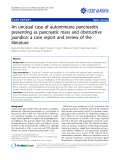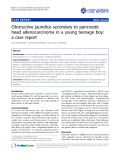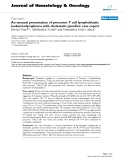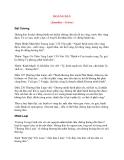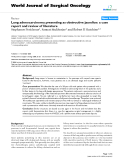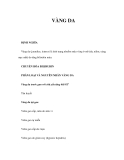
Jaundice
-
The study was done to describe clinical and subclinical features and results of treatment of neonatal unconjugated hyperbilirubinemia due to maternal child blood group incompatibility at Haiphong Children’s Hospital from 2017 to 2022.
 12p
12p  vibecca
vibecca
 01-10-2024
01-10-2024
 0
0
 0
0
 Download
Download
-
Vernonia amygdalina Delile is a shrub or small tree that is mainly grown in tropical areas of Africa. In Africa, it can be used as a traditional treatment for diabetes, emesis, nausea, dermatitis, arthristis, ascariasis, stomached, anaemia, jaundice, pneumonia, fever, tonsillitis and anti-inflammatory. The studies of the chemical components have shown that V. amygdalina contains steroids, terpenoids, saponins, polyphenolics, alkaloids, cardiac glycosides, anthraquinone and coumarins.
 7p
7p  abcxyz123_02
abcxyz123_02
 03-03-2020
03-03-2020
 13
13
 2
2
 Download
Download
-
Tuyển tập báo cáo các nghiên cứu khoa học quốc tế ngành y học dành cho các bạn tham khảo đề tài: Cholestatic jaundice, acute kidney injury and acute pancreatitis secondary to the recreational use of methandrostenolone: a case report...
 5p
5p  thulanh26
thulanh26
 08-12-2011
08-12-2011
 74
74
 4
4
 Download
Download
-
Tuyển tập báo cáo các nghiên cứu khoa học quốc tế ngành y học dành cho các bạn tham khảo đề tài: Precursor B-cell acute lymphoblastic leukemia presenting as obstructive jaundice: a case report...
 4p
4p  thulanh25
thulanh25
 07-12-2011
07-12-2011
 54
54
 5
5
 Download
Download
-
Tuyển tập báo cáo các nghiên cứu khoa học quốc tế ngành y học dành cho các bạn tham khảo đề tài: An unusual case of autoimmune pancreatitis presenting as pancreatic mass and obstructive jaundice: a case report and review of the literature...
 4p
4p  thulanh25
thulanh25
 07-12-2011
07-12-2011
 36
36
 4
4
 Download
Download
-
Tuyển tập báo cáo các nghiên cứu khoa học quốc tế ngành y học dành cho các bạn tham khảo đề tài: Obstructive jaundice secondary to pancreatic head adenocarcinoma in a young teenage boy: a case report
 3p
3p  toshiba24
toshiba24
 07-12-2011
07-12-2011
 70
70
 4
4
 Download
Download
-
Tuyển tập báo cáo các nghiên cứu khoa học quốc tế ngành y học dành cho các bạn tham khảo đề tài: An unusual presentation of precursor T cell lymphoblastic leukemia/lymphoma with cholestatic jaundice: case report
 6p
6p  toshiba24
toshiba24
 06-12-2011
06-12-2011
 46
46
 4
4
 Download
Download
-
Đại Cương Hoàng đản là một chứng bệnh mà triệäu chứng chủ yếu là da vàng, nước tiểu vàng đậm. Từ xa xưa, sách y học cổ truyền đã nhận thức về chứng bệnh này. Thiên 'Bình Nhân Khí Tượng Luận’ (Tố Vấn) ghi: “Người bệnh nước tiểu vàng đậm, nằm yên... mắt vàng... người đau, sắc hơi vàng, lợi răng vàng, móng tay chân vàng là chứng hoàng đản”. Thiên ‘Ngọc Cơ Chân Tạng Luận’ (Tố Vấn 19): “Bệnh ở Can truyền sang Tỳ, gọi là chứng Tỳ phong, phát bệnh đản”. Thiên ‘Kinh Mạch’ (Linh Khu 10) viết:...
 11p
11p  abcdef_39
abcdef_39
 22-10-2011
22-10-2011
 91
91
 8
8
 Download
Download
-
Tuyển tập báo cáo các nghiên cứu khoa học quốc tế ngành y học dành cho các bạn tham khảo đề tài: Lung adenocarcinoma presenting as obstructive jaundice: a case report and review of literature
 6p
6p  matuot_238
matuot_238
 13-10-2011
13-10-2011
 87
87
 4
4
 Download
Download
-
Vàng da (jaundice, icterus) là tình trạng nhuốm màu vàng ở mô (da, niêm, củng mạc mắt) do tăng bilirubin máu. CHUYỂN HÓA BILIRUBIN PHÂN LOẠI VÀ NGUYÊN NHÂN VÀNG DA Vàng da trước gan với chủ yếu tăng bili GT Tán huyết Vàng da tại gan Viêm gan cấp, mãn do siêu vi Viêm gan tự miễn Viêm gan cấp do rượu Viêm gan do giảm oxy (hypoxic hepatitis) Tổn thương gan do độc tố Xơ gan sau viêm gan siêu vi, do rượu, xơ gan ứ mật nguyên phát. Ung thư tế bào gan. Vàng da liên quan đến thai ky. Vàng da do tắc mật sau...
 8p
8p  lananhanh123
lananhanh123
 29-08-2011
29-08-2011
 123
123
 9
9
 Download
Download
-
Hoàng đản là một chứng bệnh mà triệäu chứng chủ yếu là da vàng, nước tiểu vàng đậm. Từ xa xưa, sách y học cổ truyền đã nhận thức về chứng bệnh này. Thiên 'Bình Nhân Khí Tượng Luận’ (Tố Vấn) ghi: “Người bệnh nước tiểu vàng đậm, nằm yên... mắt vàng... người đau, sắc hơi vàng, lợi răng vàng, móng tay chân vàng là chứng hoàng đản”. Thiên ‘Ngọc Cơ Chân Tạng Luận’ (Tố Vấn 19): “Bệnh ở Can truyền sang Tỳ, gọi là chứng Tỳ phong, phát bệnh đản”. Thiên ‘Kinh Mạch’ (Linh Khu 10) viết: “Tỳ,...
 20p
20p  congan1209
congan1209
 09-01-2011
09-01-2011
 172
172
 9
9
 Download
Download
-
Fever is the most common presenting sign of liver abscess. Some patients, particularly those with associated disease of the biliary tract, have symptoms and signs localized to the right upper quadrant, including pain, guarding, punch tenderness, and even rebound tenderness. Nonspecific symptoms, such as chills, anorexia, weight loss, nausea, and vomiting, may also develop. Only 50% of patients with liver abscesses, however, have hepatomegaly, right-upper-quadrant tenderness, or jaundice; thus, half of patients have no symptoms or signs to direct attention to the liver.
 5p
5p  thanhongan
thanhongan
 07-12-2010
07-12-2010
 55
55
 3
3
 Download
Download
-
Figure 101-6 Peripheral blood smear from a 5-year-old G6PD-deficient boy with acute favism. A very small minority of subjects with G6PD deficiency have CNSHA of variable severity. The patient is always a male, usually with a history of NNJ, who may present with anemia or unexplained jaundice, or because of gallstones later in life. The spleen may be enlarged. The severity of anemia ranges from borderline to transfusion-dependent. The anemia is usually normo-macrocytic, with reticulocytosis. Bilirubin and LDH are increased.
 5p
5p  thanhongan
thanhongan
 07-12-2010
07-12-2010
 128
128
 4
4
 Download
Download
-
Clinical Presentation and Diagnosis The spectrum of clinical severity of HS is broad. Severe cases may present in infancy with severe anemia, whereas mild cases may present in young adults or even later in life. In women, HS is sometimes first diagnosed when anemia is investigated during pregnancy. The main clinical findings are jaundice, an enlarged spleen, and often gallstones; frequently it is the finding of gallstones in a young person that triggers diagnostic investigations.
 5p
5p  thanhongan
thanhongan
 07-12-2010
07-12-2010
 89
89
 4
4
 Download
Download
-
Table 101-2 General Features of Hemolytic Disorders General examination Jaundice, pallor Other findings physical Spleen may be enlarged; bossing of skull in severe congenital cases Hemoglobin From normal to severely reduced MCV, MCH Usually increased Reticulocytes Increased Bilirubin Increased (mostly unconjugated) LDH Increased (up to 10X normal with intravascular hemolysis) Haptoglobin Reduced to absent Note: MCV, mean corpuscular volume; MCH, mean corpuscular hemoglobin; LDH, lactate dehydrogenase.
 5p
5p  thanhongan
thanhongan
 07-12-2010
07-12-2010
 70
70
 5
5
 Download
Download
-
Physical Findings Patients with early disease may not have any significant abnormalities detectable on physical examination. Jaundice may be a presenting feature in some; in these patients a palpable, nontender gallbladder (Courvoisier's sign) may be palpated under the right costal margin. Patients with more advanced disease may have an abdominal mass, hepatomegaly, splenomegaly, or ascites. The left supraclavicular lymph node (Virchow's node) may be involved with tumor, or widespread peritoneal disease may be palpable on rectal examination in the pouch of Douglas.
 6p
6p  konheokonmummim
konheokonmummim
 03-12-2010
03-12-2010
 96
96
 3
3
 Download
Download
-
Carcinoma of the Ampulla of Vater This tumor arises within 2 cm of the distal end of the common bile duct, and is mainly (90%) an adenocarcinoma. Locoregional lymph nodes are commonly involved (50%), and the liver is the most frequent site for metastases. The commonest clinical presentation is jaundice, and many patients also have pruritus, weight loss, and epigastric pain. Initial evaluation is performed with an abdominal ultrasound to assess vascular involvement, biliary dilatation, and liver lesions. This is followed by a CT scan, or MRI and especially MRCP.
 6p
6p  konheokonmummim
konheokonmummim
 03-12-2010
03-12-2010
 69
69
 5
5
 Download
Download
-
Table 88-6 Some Novel Medical Treatments for Hepatocellular Carcinoma EGF receptor antibody Erlotinib, Gefitinib Kinase antagonists, Sorafenib Vitamin K IL-2 131 I – ethiodol (Lipiodol) 131 I – Ferritin 90 Yttrium microspheres 166 Holmium Three-dimensional conformal radiation Proton beam high-dose radiotherapy Anti-angiogenesis strategies, Bevacizumab Note: EGF, epidermal growth factor; IL, interleukin. Summary Most Common Modes of Patient Presentation 1.
 5p
5p  konheokonmummim
konheokonmummim
 03-12-2010
03-12-2010
 84
84
 5
5
 Download
Download
-
Approach to the Patient: Hepatocellular Carcinoma History and Physical The history is important in evaluating putative predisposing factors, including a history of hepatitis or jaundice, blood transfusion, or use of intravenous drugs. A family history of HCC or hepatitis should be sought, and a detailed social history taken to include job descriptions for industrial exposure to possible carcinogenic drugs as well as contraceptive hormones.
 5p
5p  konheokonmummim
konheokonmummim
 03-12-2010
03-12-2010
 72
72
 2
2
 Download
Download
-
Physical Signs Hepatomegaly is the most common physical sign, occurring in 50–90% of patients. Abdominal bruits are noted in 6–25%, and ascites occurs in 30–60% of patients. Ascites should be examined by cytology. Splenomegaly is mainly due to portal hypertension. Weight loss and muscle wasting are common, particularly with rapidly growing or large tumors. Fever is found in 10–50% of patients, from unclear cause. The signs of chronic liver disease may be present, including jaundice, dilated abdominal veins, palmar erythema, gynecomastia, testicular atrophy, and peripheral edema.
 5p
5p  konheokonmummim
konheokonmummim
 03-12-2010
03-12-2010
 63
63
 3
3
 Download
Download
CHỦ ĐỀ BẠN MUỐN TÌM








